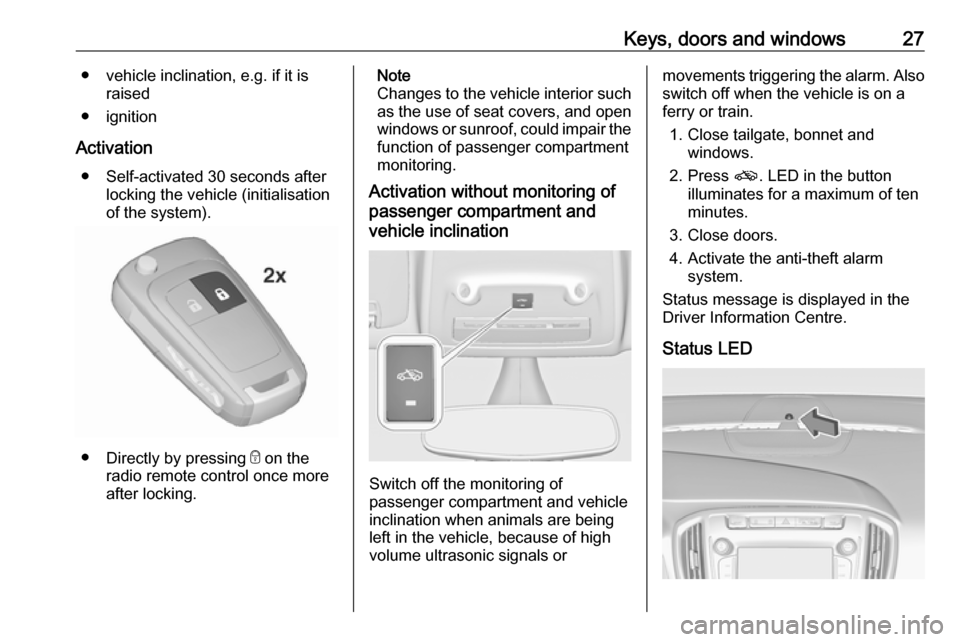lock OPEL ZAFIRA C 2017.5 Manual user
[x] Cancel search | Manufacturer: OPEL, Model Year: 2017.5, Model line: ZAFIRA C, Model: OPEL ZAFIRA C 2017.5Pages: 293, PDF Size: 9.02 MB
Page 27 of 293

Keys, doors and windows25The settings can be saved for the key
being used 3 22.
Child locks9 Warning
Use the child locks whenever
children are occupying the rear
seats.
Using a key or suitable screwdriver,
turn the child lock in the rear door to
the horizontal position. The door
cannot be opened from the inside. For
deactivation turn the child lock to the
vertical position.
Doors
Load compartment Tailgate
Opening
After unlocking, push the touchpad
switch under the tailgate moulding
and open the tailgate.
Central locking system 3 22.
Closing
Use the interior handle.
Do not push the touchpad switch
under the tailgate moulding whilst
closing as this will unlock the tailgate
again.
Central locking system 3 22.
Page 28 of 293

26Keys, doors and windowsGeneral hints for operating
tailgate9 Danger
Do not drive with the tailgate open
or ajar, e.g. when transporting
bulky objects, since toxic exhaust
gases, which cannot be seen or
smelled, could enter the vehicle.
This can cause unconsciousness
and even death.
Caution
Before opening the tailgate, check overhead obstructions, e.g. a
garage door, to avoid damage to
the tailgate. Always check the
moving area above and behind the
tailgate.
Note
The installation of certain heavy
accessories onto the tailgate may
affect its ability to remain open.
Vehicle security
Anti-theft locking system9 Warning
Do not use the system if there are
people in the vehicle! The doorscannot be unlocked from the
inside.
The system deadlocks all the doors. All doors must be closed otherwise
the system cannot be activated.
Unlocking the vehicle disables the
mechanical anti-theft locking system.
This is not possible with the central
locking button.
Activating
Press e on the radio remote control
twice within 5 seconds.
Anti-theft alarm system
The anti-theft alarm system is
combined with the anti-theft locking
system.
It monitors: ● doors, tailgate, bonnet
● passenger compartment including adjoining load
compartment
Page 29 of 293

Keys, doors and windows27● vehicle inclination, e.g. if it israised
● ignition
Activation ● Self-activated 30 seconds after locking the vehicle (initialisation
of the system).
● Directly by pressing e on the
radio remote control once more
after locking.
Note
Changes to the vehicle interior such
as the use of seat covers, and open
windows or sunroof, could impair the
function of passenger compartment
monitoring.
Activation without monitoring of
passenger compartment and
vehicle inclination
Switch off the monitoring of
passenger compartment and vehicle
inclination when animals are being
left in the vehicle, because of high
volume ultrasonic signals or
movements triggering the alarm. Also switch off when the vehicle is on a
ferry or train.
1. Close tailgate, bonnet and windows.
2. Press o. LED in the button
illuminates for a maximum of ten
minutes.
3. Close doors.
4. Activate the anti-theft alarm system.
Status message is displayed in the
Driver Information Centre.
Status LED
Page 30 of 293

28Keys, doors and windowsStatus LED is integrated into the
sensor on top of the instrument panel.
Status during the first 30 seconds of
anti-theft alarm system activation:LED illuminates:test, arming delayLED flashes
quickly:doors, tailgate or
bonnet not
completely closed,
or system fault
Status after system is armed:
LED flashes
slowly:system is armed
Seek the assistance of a workshop in
the event of faults.
Deactivation Unlocking the vehicle deactivates the
anti-theft alarm system.
Alarm When triggered, the alarm horn
sounds and the hazard warning lights flash simultaneously. The number
and duration of alarm signals are
stipulated by legislation.
The alarm can be silenced by
pressing any button on the radio
remote control or by switching on the
ignition.
The anti-theft alarm system can be
deactivated only by pressing c or by
switching on the ignition.
A triggered alarm, which has not been interrupted by the driver, will be
indicated by the hazard warning
lights. They will flash quickly three
times when the vehicle is next
unlocked with the radio remote
control. Additionally, a warning
message is displayed in the Driver
Information Centre after switching on
the ignition.
Vehicle messages 3 123.
If the vehicle's battery is to be
disconnected (e.g. for maintenance
work), the alarm siren must be
deactivated as follows: switch the
ignition on then off, then disconnect
the vehicle's battery within
15 seconds.Immobiliser
The system is part of the ignition
switch and checks whether the
vehicle is allowed to be started with
the key being used.
The immobiliser is activated
automatically after the key has been removed from the ignition switch.
If the control indicator d flashes when
the ignition is on, there is a fault in the system; the engine cannot be started.
Switch off the ignition and repeat the
start attempt.
If the control indicator continues
flashing, attempt to start the engine
using the spare key and seek the
assistance of a workshop.
Note
The immobiliser does not lock the
doors. You should always lock the
vehicle after leaving it and switch on the anti-theft alarm system 3 22,
3 26.
Control indicator d 3 116.
Page 41 of 293

Seats, restraints39Manual seat adjustment
Drive only with engaged seats and
backrests.
Longitudinal adjustment
Pull handle, slide seat, release
handle. Try to move the seat back and forth to ensure that the seat is locked
in place.
Backrest inclination
Pull lever, adjust inclination and
release lever. Allow the backrest to
engage audibly.
Seat height
Lever pumping motion
up:seat higherdown:seat lower
Page 45 of 293

Seats, restraints43FlexConsole armrest
The armrest can be moved in a centre
console. Pull the handle to slide the
armrest.
There are two storages, a storage
drawer and a movable cupholder in
the armrest console.
Armrest storage 3 69.
Removing the armrest
Flex console armrest can be
removed.
Press fastenings inward and fold down locking mechanism at the rear
end of the armrest.
Pull the handle in front of the armrest
and slide armrest rearwards out of the
console.
Installation in reverse order.
Heating
Adjust heating to the desired setting
by pressing ß for the respective seat
one or more times. The control
indicator in the button indicates the
setting.
Prolonged use of the highest setting
for people with sensitive skin is not
recommended.
Page 47 of 293

Seats, restraints45
Pull the loop, adjust inclination,
release strap and allow backrest to
engage.
9 Warning
Use vertical position of the
backrest only for increased
luggage volume and not as
seating position.
Load compartment, folding down the
backrests 3 79.
Easy entry function
To permit an easy entrance to the
seats of the third row, the outer seats
of the second row can be tilted.
Pull release lever, fold backrest and
move the seat to the front.Folding back easy entry
First move seat to desired position
and then raise backrest.9 Warning
When folding up, ensure that the
seat is securely locked in position
before driving. Failure to do so
may result in personal injury in the event of hard braking or a collision.
Lounge seats
Two types of use are possible:
Normal seats, all three seats are
usable and individually adjustable.
Lounge seats, only outer seats are
usable but with most comfortable
adjustment.
Seat positioning
In normal position, the three seats of
the second seat row can be
individually moved in longitudinal
direction.
Pull handle under the seat, slide seat, release handle and allow seat to
engage.
Page 50 of 293

48Seats, restraintsEasy entry function
To permit an easy entrance to the
seats of the third row, the outer seats of the second row can be tilted.
Pull release lever, fold backrest and
move the seat towards the front.Caution
With seats in lounge position:
● Do not use easy entry function.
● Do not pull strap to adjust backrest inclination.
This would damage the seats.
Folding back easy entry
First move seat to desired position
and then raise backrest.9 Warning
When folding up, ensure that the
seat is securely locked in position
before driving. Failure to do so
may result in personal injury in the event of heavy braking or collision.
Third row seats
9 Warning
When seats or backrests of
second and third seat row are
being adjusted or folded, keep
hands and feet away from the
moving area.
Never store objects under the
seats.
Never adjust seats while driving as they could move uncontrollably.
Drive only with engaged seats and
backrests.
Caution
Before setting up or folding down
seats, all components must be
removed from the side rails and
from the lashing eyes.
Lashing eyes must be in stored
position.
The seats in the third row can be folded down to the vehicle floor if they are not required, or for increasing the
size of the load compartment.
The seats in the third row can only be
used if the second seat row is not in
the lounge position.
Page 52 of 293

50Seats, restraintsSeat belts
The seat belts are locked during
heavy acceleration or deceleration of
the vehicle, holding the occupants in
the seat position. Therefore the risk of injury is considerably reduced.
9 Warning
Fasten seat belt before each trip.
In the event of an accident, people
not wearing seat belts endanger their fellow occupants and
themselves.
Seat belts are designed to be used by only one person at a time. Child
restraint system 3 60.
Periodically check all parts of the belt
system for damage, soiling and
proper functionality.
Have damaged components
replaced. After an accident, have the
belts and triggered belt pretensioners replaced by a workshop.
Note
Make sure that the belts are not
damaged by shoes or sharp-edged
objects or trapped. Prevent dirt from
getting into the belt retractors.
Seat belt reminder
Each seat is equipped with a seat belt
reminder, indicated for front seats by
control indicator X in the tachometer
3 111, or for rear seats by symbols
X or > in the Driver Information
Centre 3 117.
Belt force limiters
On the front seats, stress on the body is reduced by the gradual release of
the belt during a collision.Belt pretensioners
In the event of a head-on or rear-end
collision of a certain severity, the front
seat belts are tightened.9 Warning
Incorrect handling (e.g. removal or
fitting of belts) can trigger the belt
pretensioners.
Deployment of the belt pretensioners
is indicated by continuous illumination
of control indicator v 3 111.
Triggered belt pretensioners must be replaced by a workshop. Belt
pretensioners can only be triggered
once.
Note
Do not affix or install accessories or
other objects that may interfere with
the operation of the belt
pretensioners. Do not make any
modifications to belt pretensioner components as this will invalidate
the vehicle type approval.
Page 55 of 293

Seats, restraints53
Push the top latch plate into the
retainer. Fold over locked together latch plates against the seat belt.
Insert in the seat belt holder in the roof
with the lower latch plate pointing
forward.
Seat belts on the third seat row The seat belts on the third seat row
are equipped with three point seat
belts.
When seat belts are not used or when
folding the seats, insert the latch plate of the seat belt on each side into the
pocket that is mounted at the belt.
If the centre seat of the second seat
row is occupied and the seat belt is
fastened, only persons with a body
height up to max. 150 cm are allowed
to use the left seat of the third seat
row.
There is a warning label on the rear
side of the centre belt, when it is
pulled out, to inform the passenger on the left seat of the third seat row.
Using seat belts while pregnant9 Warning
The lap belt must be positioned as
low as possible across the pelvis
to prevent pressure on the
abdomen.